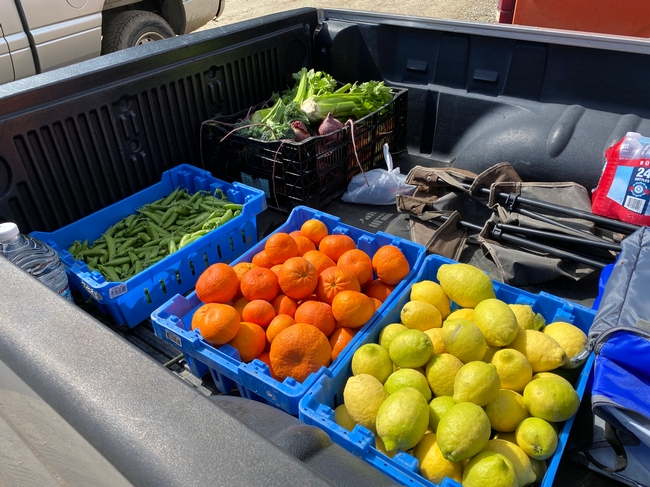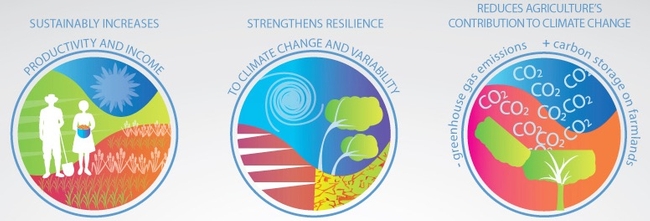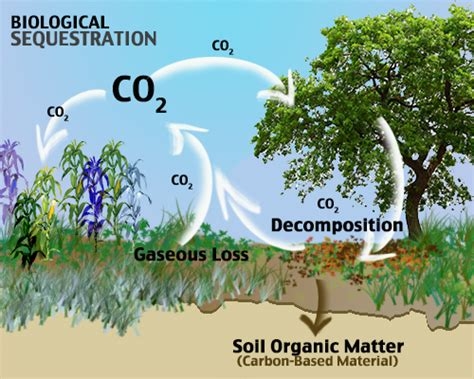
Posts Tagged: UC
New Online Course Now Available: An Integrated Approach to Managing Ground Squirrels and Pocket Gophers
We're pleased to announce that a new online course on managing ground squirrels and pocket gophers has been added to UC IPM's growing library of online training courses. This course consists of eight video segments recorded by Dr. Roger Baldwin, a...
Fireworks in the Garden: Octopus Agave in Bloom
In this weekly blog, Dr. Annemiek Schilder, Director, UCCE Ventura County and Hansen Agricultural Research and Extension Center, shares her observations about the natural world across the seasons. As she says:
"Gently observing your surroundings with curiosity will teach you some amazing things. There are so many fascinating things happening under our noses, only wanting for an observant eye."
The flowering spikes of the octopus agave (Agave vilmoriniana), currently in bloom in the Master Gardener Demonstration Garden at HAREC in Santa Paula, are seriously impressive at more than 12 feet tall. Octopus agave is a drought-tolerant plant native to the Mexican desert where it grows on rocky ground. The gray-green smooth, twisting leaves with flexible spikes at the tips give the plant an octopus-like appearance. Like other agaves, it is monocarpic, flowering only once in its life before it dies.
Agaves belong to the family Asparagaceae and are therefore related to asparagus. Indeed, young flower spikes may resemble giant asparagus spears. Flowering usually occurs between 6 and 25 years of age. The plant invests all of its energy into producing a spectacular flower display as its last hurrah. The copious small yellow flowers start opening at the bottom of the spike, moving upwards in waves. Flowering may occur over a period of 4 to 8 weeks.
Agave flowers are a magnet for pollinating insects and hummingbirds. However, in their native habitat, nectar-feeding bats, such as the lesser long-nosed bat and the Mexican long-tongued bat, play an important role in agave flower pollination. This may also explain the height of the flower spikes. Bats pollinate at night and are critical for seedset. In the absence of these specialized bats, fewer than 5% of the flowers may produce seed. Commercial cultivation of agave for tequila, which involves cutting off flower stalks, as well as pesticides and habitat destruction have been put forward as reasons for the current endangered status of some of these bat species in Mexico.
In addition to seeds, plantlets called “bulbils” may be produced in large numbers on spent flower stalks. These bulbils are exact clones of the mother plant and will root readily when planted in soil. While clonal reproduction is a good short-term strategy for plant survival, it does limit genetic diversity which makes the species less adaptable to environmental changes in the long term.
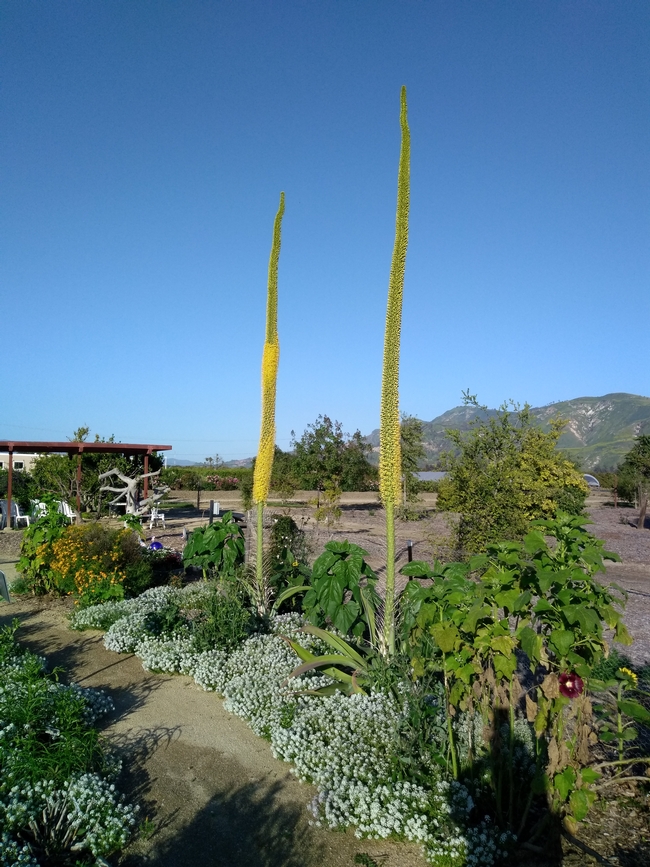
TREEmendous Learning Webinars for Middle and High School Students
This is a cross-post from the "Topics in Subtropics" blog.
Join us on alternate Tuesdays in May and June, 3:00 pm to 4:00 pm, for this opportunity designed for middle and high school students. Treemendous Tuesdays is a collaboration of U.S. Forest Service, Los Angeles Center for Urban Natural Resources, California Project Learning Tree, California 4-H, and University of California Agriculture and Natural Resources.
Five webinars will be hosted every other week starting May 5 and ending June 30. These events are free and registration is required. Flyer is attached. Dates, topics, and link to registration are below.
Please share this online opportunity with organizations, community members, teachers, parents, and students. We look forward to giving students a glimpse of the wonders and benefits that trees offer!
- May 5: Invasive Species (invasive shot hole borers)
- May 19: Invasive Plants & Trees
- June 2: Benefits of the Urban Forest
- June 16: iTree
- June 30: Living with Fire
Register https://ucanr.edu/survey/survey.cfm?surveynumber=29846
UC HAREC Donates Fruits and Vegetables to Food Forward and Ventura Schools
Nearly two tons of fruit and vegetables grown at UC's Hansen Agricultural Research and Extension Center (HAREC) in Santa Paula have been donated to Food Forward and the Ventura Unified School District (VUSD), destined for children and families.
Some of the vegetables – planted by volunteers and farm staff - became available when UC HAREC's farm field trips were canceled due to COVID-19. Other vegetables were harvested from the student farm located at HAREC, a partnership with VUSD and the city of Ventura. Kale and lettuce at the student farm were planted by youth from DATA and Montalvo schools.
Every fall and spring, volunteers from the UC Master Gardener program propagate seedlings for schools, bundling them into variety packs of vegetables and herbs, which are given to schools with gardens. Because of COVID-19, plants were given to schools for direct distribution to families. Ventura Unified School District staff partnering in this effort include Kara Muniz, Director of Food and Nutrition Services; Ashely Parrish Decker, Nutrition Educator, who runs the Student Farm; and Alise Echles, RDN.
Additional fruit and vegetables were harvested from HAREC's citrus demonstration area, the site's educational gardens and the farm grounds.
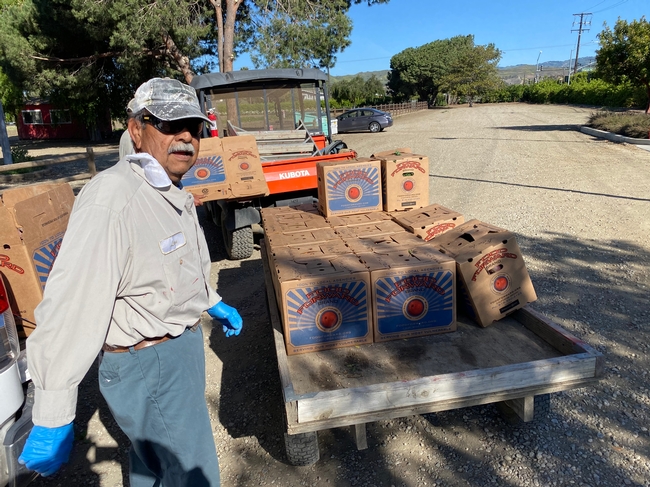
UCCE's education program manager Susana Bruzzone-Miller said, “We are saddened that spring field trip season is cancelled and miss the sound of children delighting in harvesting, sometimes for the very first time. But, it warms my heart that our field trip garden can help feed so many families in need.”
John Antongiovanni, farm manager, worked with the farm staff to organize the harvest. He said, “Working together during this difficult time is very rewarding.”
Food Forward is a gleaning organization that helps residents turn the surplus produce grown on their property into a nutritious food source for local communities. Rick Nahmias, founder and executive director, indicated that the Food Forward Backyard Harvest team remains active, and may be reached via phone at 805.630.2728 or email.

IMG 20200420 153035966 HDR
Climate Smart Agriculture: What Is It and Why Is It Important?
Hello!
My name is Alli Rowe, Ventura County UC Cooperative Extension's Community Education Specialist working to promote and expand the adoption of science-based climate smart farming and ranching practices. I bring a background in biology, research experience on working lands and climate change, and enthusiasm for supporting food systems. Plus, I really like to talk about soil carbon. Like a lot.
Now, what exactly is climate smart agriculture? The Food and Agriculture Organization of the United Nations coined the term climate smart agriculture as “an approach that helps to guide actions needed to transform and reorient agricultural systems to effectively support development and ensure food security in a changing climate”. In short, climate smart agriculture addresses how to manage agricultural systems to meet the nutritional needs of a growing population while both building resiliency to climate change and using agriculture as a solution to our climate crisis.
To be effective, climate smart agriculture must meet three main objectives:
1) Increase agricultural productivity and incomes;
2) Adapt to and build resiliency to climate change; and
3) Reduce greenhouse gas emissions
Climate smart agriculture addresses the risks that agricultural production faces under a changing climate, underscores agriculture's role in solving climate change, and focuses on the importance of intensification of agriculture required to feed a global population.
California's agricultural industry is at extreme risk to the impacts of climate change. Changes in temperatures, precipitation patterns, extreme weather events, and water availability all pose a threat to the viability of agricultural production. Warming temperatures throughout the state will result in a decline of winter chill hours, increased water demand by crops, and the promotion of various pests. Projections show an increased tendency of heat wave events and an increase in duration and intensity of drought. In addition, California expects to see earlier snowmelt, resulting in increased flooding and a decrease in year-round water availability. This is a doom and gloom scenario we look towards unless we decide to act today to plan for tomorrow.
Agriculture and working lands play a significant role in climate change. According to the EPA's recent inventory, agricultural management practices contribute 8.4% of the United States' greenhouse gas (GHG) emissions. Interestingly, and encouragingly, agriculture can also act as a greenhouse gas sink by removing atmospheric carbon and storing it in plant tissue and soils. Through effective management, agriculture provides a significant solution to climate change.
This means agriculture can build resiliency to the impacts of climate change while acting as a solution to climate change. Carbon sequestration (long-term storage) in our soils is a low-tech solution that has been around since plants started photosynthesizing. Climate smart agriculture management practices focus on building soil health, increasing carbon storage in woody plants and soil, improving water use efficiency, and reducing greenhouse gas emissions associated with agricultural practices.
While climate smart agriculture practices are important to building resiliency and addressing climate change, they also tackle the essential questions of agricultural productivity. In order to feed a growing global population, existing agricultural production must be intensified. This means getting the maximum yields out of land already under cultivation so we don't go tearing out more carbon-rich forests to expand mediocre agricultural lands. Increasing soil health and hyper-efficiently managing water improves yields and reduces the cost of inputs such as fertilizer and water. Farming for a climate-smart future means farming to feed the world and keeping farmers farming.
My work centers around identifying management practices that boost agricultural productivity, save money on synthetic inputs and expensive water, build resilience to a changing climate and combat the increasing carbon emissions in our atmosphere. I look forward to sharing what farmers and ranchers are doing in Ventura County and beyond in future blog posts!
Climate smart agriculture encompasses management practices that increase soil carbon sequestration, reduce greenhouse gas emissions, improve yields and efficiencies, and promotes climate resilience. The California Department of Food and Agriculture (CDFA) supports three funding opportunities in climate smart agriculture: the Healthy Soils Program, the State Water Efficiency & Enhancement Program, and the Alternative Manure Management Program.
In a collaborative partnership, CDFA and UC Agriculture and Natural Resources have teamed up to support 10 community education specialists throughout the state to provide technical assistance and outreach for the climate smart agriculture programs. As one of these technical assistance providers, my role is to promote and support the adoption of these programs in Ventura County. If you are interested in working with me, please contact me at amrowe@ucanr.edu.


